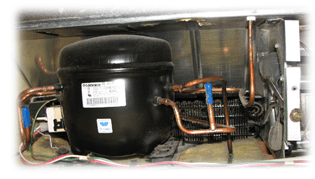With this episode we move into the category of home appliances, and the main actor of this article is the refrigerator, the indispensable equipment in each household, this being the person in charge of the store aarea our food. As you all probably know, the refrigerator is part of a larger family of equipment, more precisely in the category refrigeration equipment.
aarea our food. As you all probably know, the refrigerator is part of a larger family of equipment, more precisely in the category refrigeration equipment.
WHAT IS REFRIGERATION EQUIPMENT WASTE?
This category of electronic equipment includes a wide range of types of devices, depending on their destination and the functions they offer to home users, or in the commercial sector.
The common element that characterizes these categories of equipment is the ability to achieve heat transfer, through a fluid that is conventionally called REFRIGERATING AGENT.

The delimitation of the legislative and technical framework that governs the flow of refrigeration equipment was made for the first time in 2002, together with Directive 2002/96 / EC, followed by Directive 2012/19 / EU. The requirements of these European directives have been largely transposed into Romanian legislation, starting with 2005.
Also, the quality requirements of the collection, logistics and processing operations at the end of the life of these types of waste were established in 2012, based on SR EN 50574.
WHAT HAZARDOUS COMPONENTS DO THE REFRIGERATION EQUIPMENT CONTAIN?
Following the chronological evolution of the development of cold production technology, it can be seen that, starting with the year 1750, with the discovery of the first chemical compound that achieves this heat exchange - ether, in this type of equipment were used various chemical compounds with the role of refrigerant: ammonia, carbon dioxide, sulfur dioxide, chloromethane, to
Since 1928, because toxic effects proven that these refrigerants had on home users of refrigeration equipment, the manufacturing industry introduced a new refrigerant: CFC (chlorofluorocarbon), a chemical compound that had no effect on human health.
It was not until 1974 that they were discovered effects which this category of gases, generically called freon has them on the deterioration of the ozone layer.
With the first discovery of a hole in the ozone layer (1985) and the correlation of CFC effects with this phenomenon with global impact, the international reaction was materialized by the Montreal Protocol (1987), which imposed a gradual reduction of CFC use, replacement them with other chemical compounds (HCFC - hydrochlorofluorocarbon). International efforts at the moment are vision-oriented elimination of CFC and HCFC production and use by 2030.
The effects on the ozone layer of these substances are conventionally expressed by the GWP (Global Warming Potential) index, first introduced in the literature in 2001, by the IPCC (Intergovernmental Panel on Climate Change), a body operating under the auspices of the United Nations. .
Therefore, it can be seen, compared to the effects of carbon dioxide (CO2), the magnitude of the effects that these gases have on the deterioration of the ozone layer.
Along with these chemicals, the component part of the heat exchange system, in the waste of refrigeration equipment, are found the following components / chemicals with dangerous content:
- HALOGENATED OILS - come from the compression and cooling installation of the equipment

- MERCURY COMPONENTS - can be contained by the switches mounted on the lids of the refrigerated boxes

- CFC INSULATING MATERIALS - most refrigeration equipment contains an insulating material consisting of expanded polyurethane foam (PUR). In the process of obtaining this material, for the old equipment the expansion was made with gases from the CFC category.

- OTHER CATEGORIES OF COMPONENTS / CHEMICAL COMPOUNDS: printed circuit boards, lamps, bulbs, capacitors and so on
HOW DO WE RECYCLE REFRIGERATION EQUIPMENT?
ECOTIC, through the collection network of over 500 collection points (here you can find the collection points), ensures the non-polluting treatment of this category of waste, within the only processing plant from Romania, specialized on this stream, belonging to GREENWEEE INTERNATIONAL.
The treatment process ensures priority Pollution equipment, carried out in SECOND STAGE:
1 First stage
- Extraction of fluids from the cooling system: Oils, refrigerants: CFC / HCFC
- Oil degassing: extraction of halogenated compounds (VFC; CFC)
- Compressor removal
- Removal of other hazardous contents: capacitors, printed circuit boards, mercury switches and so on
- Removal of detachable elements: shelves, doors

2 Second stage - Treatment / Depollution of refrigeration equipment housings
- Crushing of the refrigeration equipment housings, in a “shredder” type installation, resulting in:
- Extraction of foaming agents (CFCs) from polyurethane insulation (PUR) of refrigeration equipment
- Separation of plastic fractions, ferrous metals, non-ferrous metals
- Pelletizing of depurated PUR foam

The treatment / depollution process results in the following categories of substances / materials, intended for recycling / recovery or final disposal:
- Ferrous metals: are recycled in metal smelters, in order to obtain new products

- Plastic materials: are subjected to recycling processes by repolymerization, in order to obtain new products

- Polyurethane foam. Once the expansion gases (VFC / CFC) are extracted, this material is intended for recycling or energy recovery, as appropriate.

- Refrigerants: the cooling fluids extracted from the refrigeration equipment are subjected to disposal operations
- Oils: degassed oils are intended for recycling or energy recovery, as appropriate.
The ecology lesson ends with a tip for those who are considering changing their refrigeration equipment - Recycle them for both the environment and your health!
The pictures were made with the support of GreenWeee International.

